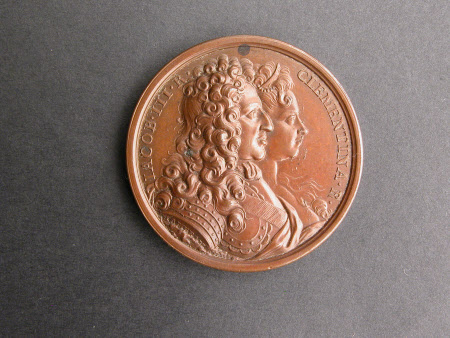The birth of Prince Charles Stuart, the Young Pretender
Ottone Hamerani (1694 - 1761)
Category
Coins and medals
Date
1720
Materials
Copper
Measurements
412 mm (Diameter)
Place of origin
Rome
Order this imageCollection
Osterley Park and House, London
NT 773303
Summary
Copper, medal commemorating the birth of Prince Charles Stuart, the Young Pretender, by Ottone Hamerani (1694-1761), struck Rome, Italy, 1720. A copper medal by Ottone Hamerani (1694-1761) commemorating the birth of Prince Charles Edward Stuart (1720-88), ‘The Young Pretender’ in Rome on 31 December 1720. The obverse has conjoined busts facing right of Charles’s parents, Prince James Francis Edward Stuart, ‘The Old Pretender’ (1688-1766) and Princess Maria Clementina Sobieska (1702-35). The Latin legend reads ‘James III King, Clementina Queen’, whilst the artist’s signature is on the truncation. On the reverse is a draped female figure of Providence, standing against a column, a small child on her left arm, and pointing with her right hand towards a globe with a map of the British Isles, inscribed with the names of their constituent nations. The Latin legend reads ‘Providence, the helper in childbirth’ and, in the exergue, ‘To Charles, Prince of Wales, born on the last day of the year 1720.’
Full description
Prince James Francis Edward Stuart, ‘The Old Pretender’, made a number of efforts to reclaim the throne of Britain and Ireland, notably the attempted invasion in 1715. In 1719 he went to Spain to take part in a planned Spanish-led invasion, but the Spanish fleet was destroyed in a storm and a rising in Scotland was defeated, following which James returned to Rome, where he took up residence in the so-called Palazzo del Re, close to the Quirinale. James also selected a bride during this period, the wealthy heiress Princess Maria Clementina Sobieska, a granddaughter of King John III of Poland. The new King George I of Britain and Ireland feared that the marriage would bring male heirs and fresh claimants to his throne, so he persuaded the Holy Roman Emperor Charles VI to have Maria Clementina arrested in Innsbruck, as she made her way to Italy. She managed however to escape from Innsbruck Castle and reach the safety of the Papal States, at which point she and James, who at this time was still in Spain, were married by proxy. Immediately on his return, James met Clementina in Montefiascone in September 1719 and solemnized their marriage, the couple then making their home in Rome in the Palazzo del Re. It was in Rome that their two sons were born, Charles Edward Stuart on 31 December 1720 and Henry Benedict Stuart (1725-1807) on 6 March 1725. Prince Charles would achieve celebrity as the romantic but ultimately disappointed figure of the Young Pretender, Bonnie Prince Charlie. The obverse of the medal with its conjoined busts, echoes earlier Stuart royal portrait medals, for example one of Charles I and Henrietta Maria (Medallic Illustrations, I, pp. 278-79, nos. 81-84; British Commemorative Medals, no. 159), or the Spanish Wreck Recovered medal of James II/VII and Mary of Modena (Medallic Illustrations, I, p. 619, no. 33; BCM no. 285; NT 773273), in this way emphasising the Jacobite legitimist claims.The reverse legend reminds us of the risks to babies and their mothers during childbirth in earlier centuries, whilst optimistically suggesting that providence, in furnishing a healthy male heir, was supporting the Jacobite cause. The column symbolises the fortitude of the Stuart dynasty in adversity. The Hamerani were a dynasty of engravers and medallists, originally from Germany, who settled in Rome in the 17th century. They became the principal die engravers and medallists in the city for some two hundred years. Jeremy Warren 2019
Provenance
Given to the National Trust in 1993 by George Child Villiers, 9th Earl of Jersey (1910-1998).
Marks and inscriptions
Obverse, legend: IACOB. III. R. CLEMENTINA. R. Obverse, on truncation: HAMERAN. Reverse, legend: PROVIDENTIA OBSTETRIX Reverse, exergue: CAROLO. PRINC: VALLIAE / NAT: DIE. VLTIMA / A : MDCCXX. Reverse, on globe: IRI. SC. ING.
Makers and roles
Ottone Hamerani (1694 - 1761), medallist
References
Cochran-Patrick 1884: Robert William Cochran-Patrick, Medals of Scotland from the earliest period to the present time, Edinburgh 1884, p. 68, no. 49, pl. XIII, Fig. 2. Hawkins, Franks and Grueber 1885: Edward Hawkins, Augustus W. Franks and Herbert A. Grueber (eds.), Medallic Illustrations of the History of Great Britain and Ireland to the death of George II, 2 vols., London 1885, vol. II, p. 452, no. 60. Skeet 1930: Francis John Angus Skeet, Stuart Papers, Pictures, Relics, Medals and Books in the Collection of Miss Maria Widdrington, Leeds 1930, p. 74. Woolf 1988: Noel Woolf, The Medallic Record of the Jacobite Movement, London 1988, p. 81, no. 38:1. Eimer 2010: Christopher Eimer, British Commemorative Medals and their Values, London 2010, p. 85, no. 488, pl. 58. Forsyth 2017: David Forsyth (ed.), Bonnie Prince Charlie and the Jacobites, exh. cat., venue: National Museum of Scotland, Edinburgh 2017, Viccy Coltman, ‘Material Matters. An Introduction to Jacobite Material Culture’, pp. 178-92, pp. 186-87, fig. 10.6.
